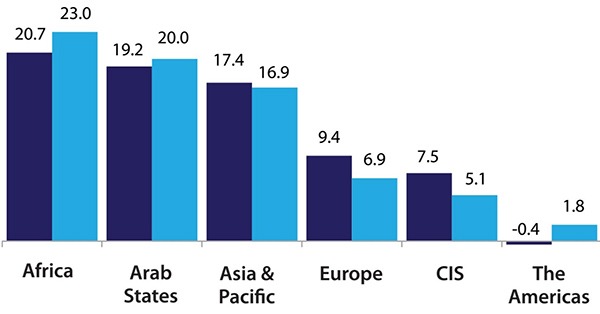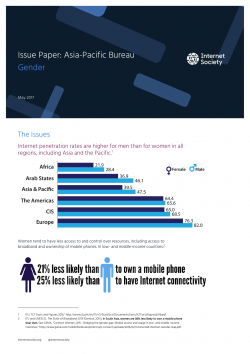The Issues
Internet penetration rates are higher for men than for women in all regions, including Asia and the Pacific.[1]
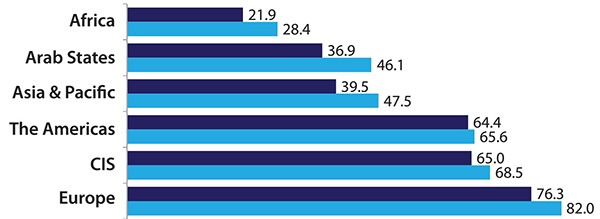
Women tend to have less access to and control over resources, including access to broadband and ownership of mobile phones. In low- and middle-income countries:[2]

A GSMA study found that women are more likely than men to own less expensive and more basic mobile phones.[3]
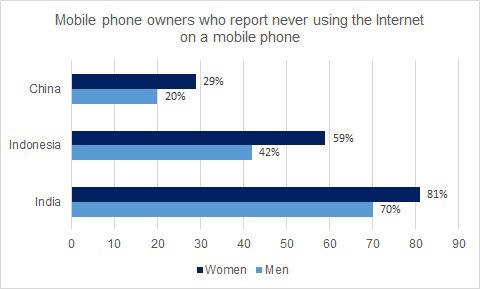
Given that mobile phones have become the main device through which people access the Internet,[4] if women continue to own less sophisticated handsets, they will also be less likely than men to have access to the Internet.
Another common way that people access the Internet is through personal computers at home, or at community multimedia centres,[5] telecentres[6] and Internet cafes. But, they are often off-limits to women due to the lack of safety measures, disapproval from family members and other socio-cultural reasons.
This means that more women than men are losing out on the benefits of the Internet to:
- Participate more easily in the labour market and increase their incomes—as e- commerce entrepreneurs, in online work, or in business process outsourcing;
- Gain access to education, health care, and financial services;[7] and
- Enable their participation in online networks to voice their concerns and advocate for change.
The Internet user gender gap in Asia and the Pacific decreased very slightly, but it still remains significant at 17%, which is higher than the global average of 12%.[8]
Globally, the Internet user gender gap grew from 11% in 2013 to 12% in 2016. Although in the Asia-Pacific, it has decreased slightly, it is still higher than the global average.[9]
According to the study by GSMA,[10] cost remains the greatest barrier to owning and using a mobile phone, particularly for women.
Security and harassment emerged as one of the top five barriers to mobile phone ownership and usage, and is a key concern for women.
Other barriers are related to service delivery issues (network quality and coverage, and agent or operator trust) and technical literacy and confidence.
But, even with gender parity in ownership, access and control over digital technologies, gains are not automatic.
In a World Wide Web Foundation study, almost every women in the survey of nine poor urban communities including in India, Indonesia and the Philippines, owned or had access to a mobile phone. But on average, only 21% of the connected women had searched for critical information on topics like health, legal rights and transport information.[11]
A survey by Womenwill, of over 5,500 women in seven countries in the Asia-Pacific, found similar results.[12] Particularly for non-users, it is the lack of relevance and the technical unfamiliarity of the Internet. For women who are online, many remain uncertain of what to do once they are online. In Indonesia, Philippines and Thailand, time constraints hold women backfrom exploring new ways to use the Internet. The time constraints is often a result of the extra burden of unpaid care work that women carry.
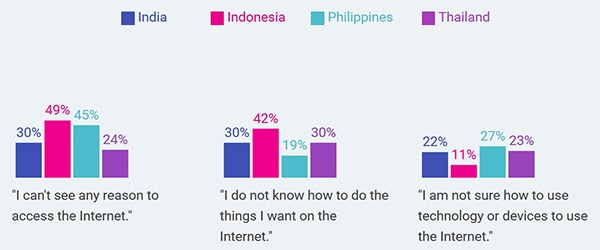
Source: Womenwill, “Asia Pacific Insight Report: Women and Technology”
Mobile connectivity is insufficient to bridge the gender digital divide.
Research shows that the dramatic spread of mobile phones is not enough to get women online, or to achieve empowerment of women through technology. Without a major escalation of gender-sensitive policy efforts and investments, most of the benefits of technology change will be captured by men, further deepening the gender divide.[13] Specifically, policy efforts could include the following:
- Teach digital skills from primary school onwards – taking advantage of near-100% primary enrolment rates to open up digital opportunities for everyone.
- Make Internet-capable devices more affordable for women.
- Make broadband cheaper – In the Asia-Pacific region, women earn on average 10- 30% less than men.[14] Cheaper broadband will enable them to go online, explore longer and more often.[15]
- Support the development of innovative last-mile connectivity, and free or low-cost public access points that are safe and women-friendly, involving women’s collectives and organizations.
- Enact adequate legislative measures to protect women and girls from online harassment and violence.
Gender-based violence needs to be urgently addressed.
Globally, one in three women experience a form of violence in her lifetime. In the last two decades, violence has spread onto online spaces. Online violence is complex as abuse cross national boundaries, and offensive content can be rapidly disseminated and difficult to erase. It is estimated that women are 27 times more likely to be abused online than men, and 9 million women have experienced violent behaviour online.[16]
The Association for Progressive Communications’ Take Back the Tech initiative encourages women around the globe to report on the violations that they face online. Findings from 1,126 cases reported, including from Pakistan and the Philippines, reveal the following:[17]
- Women 18-30 years old and younger are the most vulnerable online.
- The majority (40%) of cases are perpetrated by someone known to the survivor.
- Emotional harm (33%) impeding women’s full participation in online and offline life has been reported in a majority of cases.
- 11% of cases reported physical harm, which means that the Internet is used to facilitate offline violations and violence.
- Facebook (26%) and mobile phones (19%) are the platforms where most violations were reported.
- In less than a third of the cases reported, action has been taken by the service providers.
- Less than half of the cases (41%) reported to the authorities have been investigated.
Failure to address online violence against women significantly impedes the digital inclusion of women, and have an adverse impact on the exercise of free speech and other human rights. There is a need for a combination of preventive measures through public sensitization (including for law, courts and enforcement officers), promotion of safeguards for online safety and equality on the Internet (involving industry players), and putting in place and enforcing sanctions.[18]
Lack of understanding and political will to address underlying causes of gender inequality and discrimination.
To bridge the gender digital divide, it is necessary to understand the root causes of gender inequality and discrimination, and address the underlying barriers to these inequalities, including gender divides in education, the labour market, political participation, the ownership of resources and decision-making, caused by existing socio-cultural norms, values and attitudes.
The digital revolution is creating new forms of privileges and discrimination, as well as reinforcing existing power structures, inequalities and violence.
When more women go online, the barriers may decrease in some places as women begin to command more economic resources and autonomy, but there is also a risk of unfavourable responses, especially from men, as a result of women’s increased resources and autonomy through their access to online platforms for economic, political and social engagement.
A collective and coordinated effort is required across different sectors to understand and address gender inequality. A better understanding is also needed on how non-binary people are accessing and using the Internet. Besides anecdotal examples and case studies[19] of non- binary people using the Internet to connect with each other, voice their issues, and seek support and counselling, there is no regional data, statistics or surveys on their access to and use of the Internet.
The Opportunities
ITU, UN Women and other organizations are collaborating to bridge the digital gender divide.
The International Telecommunication Union (ITU), UN Women and other organizations have developed an “Action Plan to Close the Digital Gender Gap” in December 2015.[20] Its five focus areas are to:
- Develop gender responsive strategies and policies.
- Ensure access to ICTs by women and girls and mitigating or responding the threats online that hinder women’s access to and use of technology.
- Build digital capacities of girls and women and support development of content, applications and services that meet women’s needs.
- Promote women in the technology sector, including into positions of decision- making.
- Establish multi-stakeholder partnerships to advance women’s empowerment within the Information Society and strengthen international cooperation.
In addition, ITU and the United Nations University Institute on Computing and Society developed a Gender Digital Inclusion Map[21]—a who’s doing what to close the gender digital divide – to encourage partnerships and collate good practices.
Out of the 230 initiatives documented, only 19 are from the Asia-Pacific region. The region needs to step up its efforts to document its initiatives and strengthen partnerships.
More than a third of these initiatives focus on training women in ICT skills, while mentoring, awareness raising and advocacy projects are under-represented despite their importance to closing the gender digital divide. A lack of funds and data are reported as the main obstacles for these initiatives, and to maximize their impact, projects must address the broader socio- economic and cultural environment of the women and girls they target.
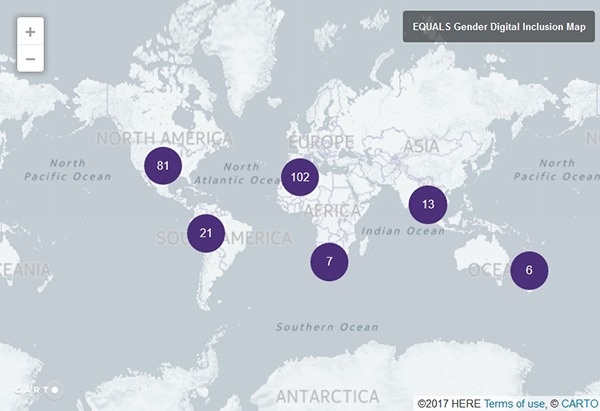
Source: ITU, “EQUALS Gender Digital Inclusion Map”
Approaches to consider to bridge the gender digital divide.
Connectivity initiatives will not overcome disparities if they are gender-neutral. Gender equality must become an explicit policy priority.
It is recommended that policies for ICT, broadband, cybersecurity, privacy, and social and economic development must include specific, time-bound targets to close the gender digital divide, developed in consultation with women’s organization, backed by adequate budget allocations and the collection of gender-disaggregated data for monitoring progress.[22]
Targeted training for women
Digital literacy programmes need to be gender sensitive. Girls are more likely than boys to be denied access to formal education, therefore there needs to be alternative ways of reaching girls. Women face more barriers than men when participating in digital literacy programmes due to their multiple roles, gender stereotypes and cultural norms, and women-targeted training may be needed.
Women and girls need to understand how current and emerging technologies can help them participate in the economy and society. They also need to be aware of their rights, including their right to online privacy so that their use of the Internet do not lead to their discrimination, harassment and violence.
Differences in digital access and use between women in rural and urban areas, and the different age groups need to be considered, as well as women with disabilities, and women of diverse sexualities and gender identities.[23]
Community is key in advancing Internet adoption
Survey by Womenwill found that women prefer to learn about the Internet from family and friends.
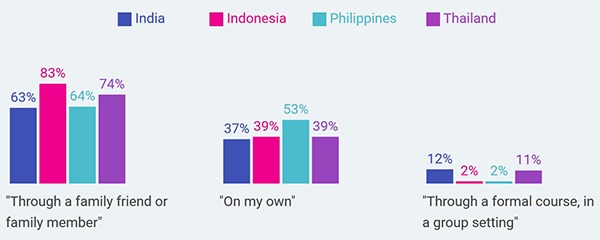
Source: Womenwill, “Asia Pacific Insight Report: Women and Technology”
Community workers to nurture women’s appreciation for, and trust in, digital services are also critical to increasing women’s adoption of the Internet. Examples include Infoladies in Bangladesh and knowledge workers in Community eCentres of the Philippines.
Online content by women for women is a strong motivation for women to use technology
Part of the solution to changing online culture is through the creation of gender-sensitive content. This requires moving beyond digital literacy efforts to developing the capacity of women and girls as online content creators, including apps and services in local languages. This includes efforts to promote and support women’s education and careers in the fields of science, technology, engineering and mathematics.
Furthermore, content creators need an enabling policy environment that does not censor, police or penalize women.
Alignment with the SDGs
Towards digital equality, the SDGs commit United Nations member states to:
Enhance the use of enabling technology, in particular information and communications technology, to promote the empowerment of women (SDG5b).
Significantly increase access to information and communications technology and strive to provide universal and affordable access to the Internet in least developed countries by 2020 (SDG9c).
By 2030, ensure that all men and women have equal access to basic services and appropriate new technology (SDG1.4).
By 2020, enhance capacity-building support to developing countries, including for least developed countries and small island developing states, to increase significantly the availability of high-quality, timely and reliable data disaggregated by gender (SDG17.18)
Questions to Think About
What are the strategies that different development sectors, including agriculture, education, health and finance can adopt to ensure that their digital interventions are bridging the gender digital divide and not widening it?
The World Wide Web Foundation[24] singled out two kinds of content and services that are particularly critical to women’s rights and opportunities, and are also directly relevant to SDG targets: (1) online availability of sexual and reproductive health information; and (2) digital financial services. Do these align with the priority areas in your country, and if so, what are the strategies for accelerating the availability of user-friendly, locally relevant online content and services in these two areas?
What are the good practices in ensuring that public-private partnerships are gender sensitive and inclusive
How are non-binary people accessing and using the Internet? What are the barriers that they face and how can these barriers be addressed?
Endnotes
[1] ITU, “ICT Facts and Figures 2016,” http://www.itu.int/en/ITU-D/Statistics/Documents/facts/ICTFactsFigures2016.pdf.
[2] ITU and UNESCO, The State of Broadband 2015 (Geneva, 2015). In South Asia, women are 38% less likely to own a mobile phone than men. See GSMA, “Connect Women 2015 – Bridging the gender gap: Mobile access and usage in low- and middle-income countries,” http://www.gsma.com/mobilefordevelopment/wp-content/uploads/2016/02/Connected-Women-Gender-Gap.pdf.
[3] GSMA, “Connect Women 2015 – Bridging the gender gap: Mobile access and usage in low- and middle-income countries,” http://www.gsma.com/mobilefordevelopment/wp-content/uploads/2016/02/Connected-Women-Gender-Gap.pdf. Note that there are now Internet-capable devices/smartphones that are relatively simple and inexpensive, and also content providers like Facebook and Google that are making content available to those with limited connectivity, basic smartphones and feature phones.
[4] Sarah Vizard, “Smartphone Society: Mobile Phones Overtake Laptops As Top Internet Device,” Marketing Week, 6 August 2015, https://www.marketingweek.com/2015/08/06/smartphone-society-mobile-phones-overtake-laptops-as-top-internet-device/.
[5] See http://portal.unesco.org/ci/en/ev.php-URL_ID=1263&URL_DO=DO_TOPIC&URL_SECTION=201.html.
[6] See http://www.telecentre.org/.
[7] Bank account penetration rates have generally been lower for women, with a gender gap in the range of 10 to 25 percentage points in countries like India, Myanmar, Pakistan and Turkey. A MasterCard survey in India reported that 58% of the respondents found it difficult to access credit, savings and jobs because of their gender. See Issues Paper on Financial Inclusion at http://internetsociety.org/ridd/sites/internetsociety.org.afpif-2016/files/uploads/RIDD-Issues-Package-Final.pdf.
[8] ITU, “ICT Facts and Figures 2016,” http://www.itu.int/en/ITU-D/Statistics/Documents/facts/ICTFactsFigures2016.pdf.
[9] Ibid.
[10] GSMA, “Connect Women 2015 – Bridging the gender gap: Mobile access and usage in low- and middle-income countries,” http://www.gsma.com/mobilefordevelopment/wp-content/uploads/2016/02/Connected-Women-Gender-Gap.pdf.
[11] World Wide Web Foundation, “Is the Web Really Empowering Women?” http://webfoundation.org/docs/2015/10/WROinfographic.png.
[12] Womenwill surveyed 5,559 women (4,037 Internet users and 1,522 non-users) in Australia, India, Indonesia, Japan, Philippines, Republic of Korea and Thailand. See Womenwill, “Asia Pacific Insight Report: Women and Technology,” https://www.womenwill.com/insights/index.html.
[13] World Wide Web Foundation, “Global Report – Women’s Rights Online: Translating Access into Empowerment,” October 2015, http://webfoundation.org/docs/2015/10/womens-rights-online21102015.pdf.
[14] Asian Development Bank, “Do Women in Asia and the Pacific Earn Less than Their Male Colleagues?” 6 March 2015, https://www.adb.org/news/infographics/do-women-asia-and-pacific-earn-less-their-male-colleagues.
[15] A global study found that women who are able to go online daily are nearly three times more likely than infrequent users to report that the Internet has helped them to increase their income. World Wide Web Foundation, “Global Report – Women’s Rights Online: Translating Access into Empowerment,” October 2015, http://webfoundation.org/docs/2015/10/womens-rights-online21102015.pdf.
[16] Networked Intelligence for Development 2015, cited in United Nations Broadband Commission for Digital Development, “Cyber Violence Against Women and Girls,” 2015, http://www.unwomen.org/-/media/headquarters/attachments/sections/library/publications/2015/cyber_violence_gender%20report.pdf.
[17] Association for Progressive Communications, “Mapping Technology-Based Violence Against Women: Take Back the Tech! Top 8 Findings,” http://www.genderit.org/sites/default/upload/csw_map.pdf.
[18] United Nations Broadband Commission for Digital Development, “Cyber Violence Against Women and Girls,” 2015, http://www.unwomen.org/-/media/headquarters/attachments/sections/library/publications/2015/cyber_violence_gender%20report.pdf. See also Internet Governance Forum 2015: Best Practice Forum on Online Abuse and Gender-Based Violence Against Women, 8 December 2015, http://www.intgovforum.org/cms/documents/best-practice-forums/623-bpf-online-abuse-and-gbv-against-women/file.
[19] See Association for Progressive Communications and Humanist Institute for Cooperation with Developing Countries, Global Information Society Watch 2015: Sexual Rights and the Internet (2015), https://www.giswatch.org/2015-sexual-rights-and-internet.
[20] See http://www.itu.int/en/action/gender-equality/Documents/ActionPlan.pdf.
[21] ITU, “EQUALS Gender Digital Inclusion Map,” http://www.itu.int/en/action/gender-equality/Pages/equalsGDImap.aspx.
[22] Web Foundation, “Closing the Digital Divide: A Briefing Note,” 14 April 2016, http://webfoundation.org/2016/04/closing-the-digital-divide-a-briefing-note/.
[23] See Alliance for Affordable Internet, “Digging into Data on the Gender Digital Divide,” 7 October 2016, http://a4ai.org/digging-into-data-on-the-gender-digital-divide/.
[24] World Wide Web Foundation, “Women’s Rights Online: Report Cards,” http://webfoundation.org/docs/2016/09/WRO-Gender-Report-Card_Overview.pdf.
